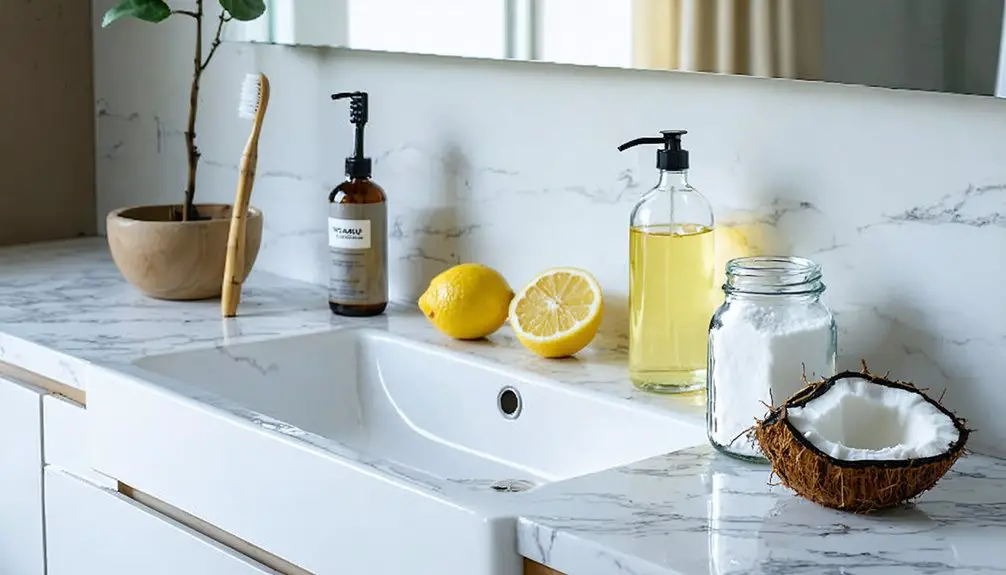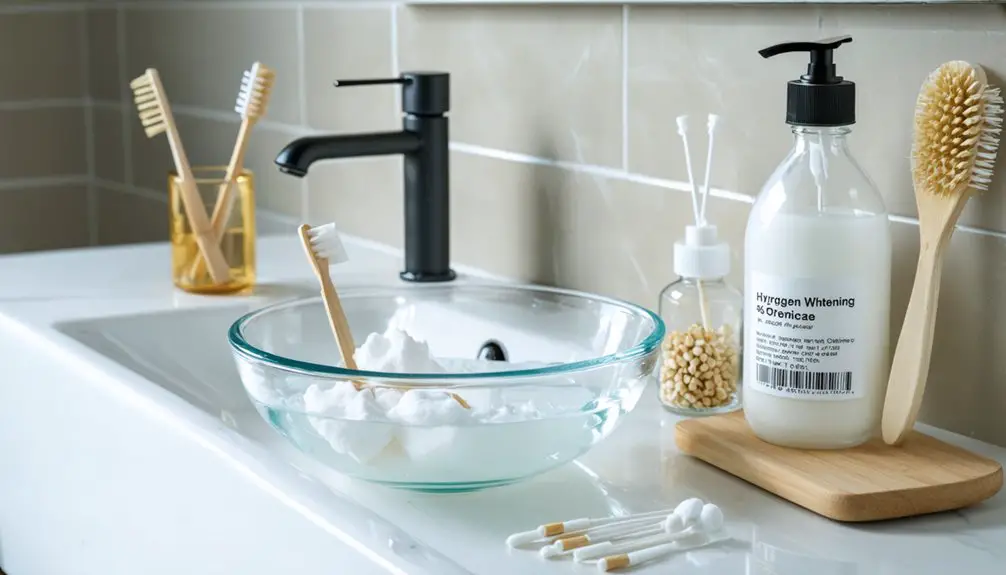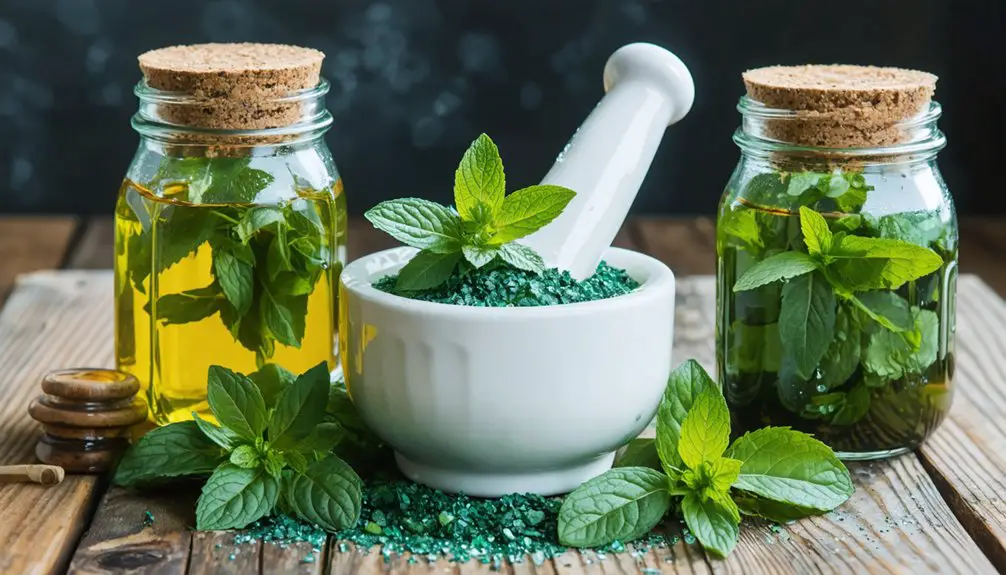You can effectively whiten your teeth at home using proven methods backed by dental research. Start with ADA-approved whitening strips containing 10-35% carbamide peroxide for safe results. Add baking soda to your brushing routine as a gentle abrasive for surface stains. Maintain strict oral hygiene with fluoride toothpaste and daily flossing. Use a straw for dark beverages, and consider professional-grade home whitening kits for ideal results. These essential techniques are just the beginning of your journey to a brighter smile.
Key Takeaways
- Brush twice daily with fluoride toothpaste and baking soda to remove surface stains and protect enamel.
- Use whitening strips containing 10-35% carbamide peroxide, following manufacturer instructions to avoid sensitivity.
- Incorporate crunchy fruits and vegetables into your diet for natural scrubbing action against stains.
- Rinse with antimicrobial mouthwash and use a straw for dark beverages to prevent staining.
- Try oil pulling with coconut oil or professional-grade home whitening kits for enhanced results.
Safe and Effective Whitening Products You Can Trust
While many teeth whitening products crowd the market, only those containing proven ingredients like hydrogen peroxide and carbamide peroxide deliver reliable results.
For safe and effective treatment, look for products with the ADA seal of acceptance, particularly whitening strips or gel trays containing 10-35% carbamide peroxide or 3-10% hydrogen peroxide.
When selecting peroxide gels or strips, choose concentrations based on your sensitivity level. Higher concentrations work faster but may cause more irritation. Professional teeth cleaning prior to starting any whitening regimen provides optimal starting results.
If you have dental restorations or sensitive teeth, opt for lower-strength products with shorter application times. Always follow manufacturer instructions carefully to avoid enamel damage or gum inflammation. Keeping teeth completely dry for optimal adhesion is essential when using whitening strips.
Most users see noticeable improvements of 2-4 shades within two weeks when using ADA-approved products as directed.
The Power of Baking Soda for a Brighter Smile
Although professional whitening treatments deliver dramatic results, baking soda offers a simple yet effective option for maintaining a brighter smile. This mild abrasive powder physically removes surface stains from coffee, tobacco, and foods while neutralizing harmful acids in your mouth.
You’ll find baking soda’s whitening action works primarily through gentle scrubbing rather than chemical bleaching. For enhanced stain removal, you can combine it with hydrogen peroxide, though you should use this mixture carefully to protect your enamel. Studies show using baking soda toothpaste significantly reduces gum bleeding compared to regular toothpaste.
Research demonstrates that gentle scrubbing action effectively removes surface stains without damaging tooth structure. While not as potent as professional treatments, baking soda’s antibacterial properties help reduce plaque and bacteria that cause discoloration.
Remember to avoid aggressive brushing and supplement with fluoride products, as baking soda alone won’t prevent cavities. Its affordability and availability make it a practical addition to your oral care routine.
Essential Daily Habits for Whiter Teeth
Maintaining a bright, healthy smile requires more than occasional whitening treatments – it demands a consistent daily routine of proven dental care practices. Your brushing techniques should include using fluoride toothpaste and an electric toothbrush for two minutes, twice daily. Regular brushing with fluoride toothpaste prevents tooth decay and keeps your smile bright. Consistent daily brushing removes food particles that can lead to discoloration.
The flossing importance can’t be overstated – clean between teeth at least once daily to remove stain-causing debris where your brush can’t reach.
- Use a straw when drinking dark beverages like coffee, tea, and wine to minimize direct contact with your teeth
- Rinse with an antimicrobial mouthwash for 30 seconds twice daily to reduce bacteria that cause stains
- Drink water throughout the day to maintain saliva production and naturally cleanse your teeth
Following these practices consistently will help you maintain professional whitening results and prevent new stains from developing.
Natural Remedies That Actually Work
For those seeking alternatives to commercial whitening products, several natural remedies have demonstrated genuine effectiveness in brightening teeth.
Baking soda, when used moderately with water or toothpaste, can safely remove surface stains while neutralizing harmful acids. Incorporating crunchy produce like apples, celery, and carrots can naturally scrub away mild stains while eating.
A time-tested home remedy, baking soda provides gentle yet effective stain removal while helping maintain your mouth’s natural pH balance.
Natural fruit enzymes found in strawberries, papaya, and pineapple offer gentler whitening effects compared to chemical treatments, though results take longer to achieve. However, be aware that acidic fruits can potentially damage tooth enamel with extended use.
Oil pulling with coconut or sesame oil may help reduce bacteria-induced stains, but it shouldn’t replace your regular oral care routine.
While activated charcoal has gained popularity, use it cautiously and under dental supervision due to its abrasive nature.
Remember to protect your progress by avoiding stain-causing beverages and foods, or use a straw when consuming them to minimize contact with your teeth.
Professional-Grade Solutions for Home Use
While natural remedies offer gentle whitening effects, professional-grade home solutions deliver more dramatic results with dental-office caliber ingredients.
Custom trays fitted to your teeth’s unique contours enable precise application of whitening gels containing up to 45% peroxide concentration. Many systems now incorporate LED technology to accelerate the whitening process, potentially achieving visible results in as little as 10 minutes per session. Opalescence PF offers effective whitening without LED lights, which can be harsh on gums. The Colgate Optic White Professional Kit features a quick-dry serum that delivers dramatically whiter teeth in just 5 days.
- Professional-grade whitening kits can lighten your teeth 2-4 shades in just 20 days, helping you serve clients with increased confidence.
- Custom-fit trays with high-water content gels minimize sensitivity while maximizing contact with tooth surfaces.
- Advanced dual-barrel systems keep ingredients fresh and potent until activation, ensuring peak results for your investment.
Frequently Asked Questions
Can Whitening Treatments Damage Existing Dental Work Like Veneers and Crowns?
Your dental work’s safety isn’t compromised by whitening products. While they won’t affect the color of veneers and crowns, these treatments don’t damage their structural integrity or maintenance requirements.
How Long Should I Wait After Whitening Before Consuming Dark Foods and Drinks?
Your teeth are practically screaming for protection! You’ll need to wait at least 48 hours after whitening before consuming dark foods and drinks, as your enamel’s more susceptible to staining during this period.
Is It Safe to Whiten Teeth While Pregnant or Breastfeeding?
Due to safety concerns and pregnancy guidelines, you shouldn’t whiten your teeth while pregnant. During breastfeeding, consult your healthcare provider first, as research is limited on whitening safety for nursing mothers.
Can Medications Affect the Success of Teeth Whitening Treatments?
Yes, you’ll find that certain medications greatly impact whitening effectiveness. Tetracycline antibiotics cause stubborn intrinsic stains, while antihistamines and blood pressure medications create extrinsic discoloration that’s more treatable through whitening procedures.
Will Whitening Make My Teeth More Sensitive to Hot and Cold Permanently?
Your teeth’s sensitivity duration is usually temporary, lasting days to weeks. Permanent sensitivity is rare when following prevention tips like using custom trays and avoiding overuse of whitening products.
References
- https://www.listerine.com/teeth-whitening/whitening-teeth-instructions
- https://www.hyannisdental.com/blog/brighten-your-smile-naturally-6-simple-ways-to-whiten-teeth-at-home/
- https://www.webmd.com/oral-health/teeth-whitening
- https://newsnetwork.mayoclinic.org/discussion/mayo-clinic-q-and-a-many-safe-choices-available-to-help-whiten-teeth/
- https://www.healthline.com/health/dental-and-oral-health/how-to-get-rid-of-yellow-teeth
- https://www.goodhousekeeping.com/health-products/g28723133/best-at-home-teeth-whitening-products/
- https://nhdentistrybeverlyhills.com/press/6-of-the-best-teeth-whitening-kits-in-the-drugstore/
- https://www.goodrx.com/conditions/dental-care/is-teeth-whitening-safe
- https://pmc.ncbi.nlm.nih.gov/articles/PMC4058574/
- https://southeasterndentalcenter.com/baking-soda-a-natural-solution-for-whiter-teeth/



